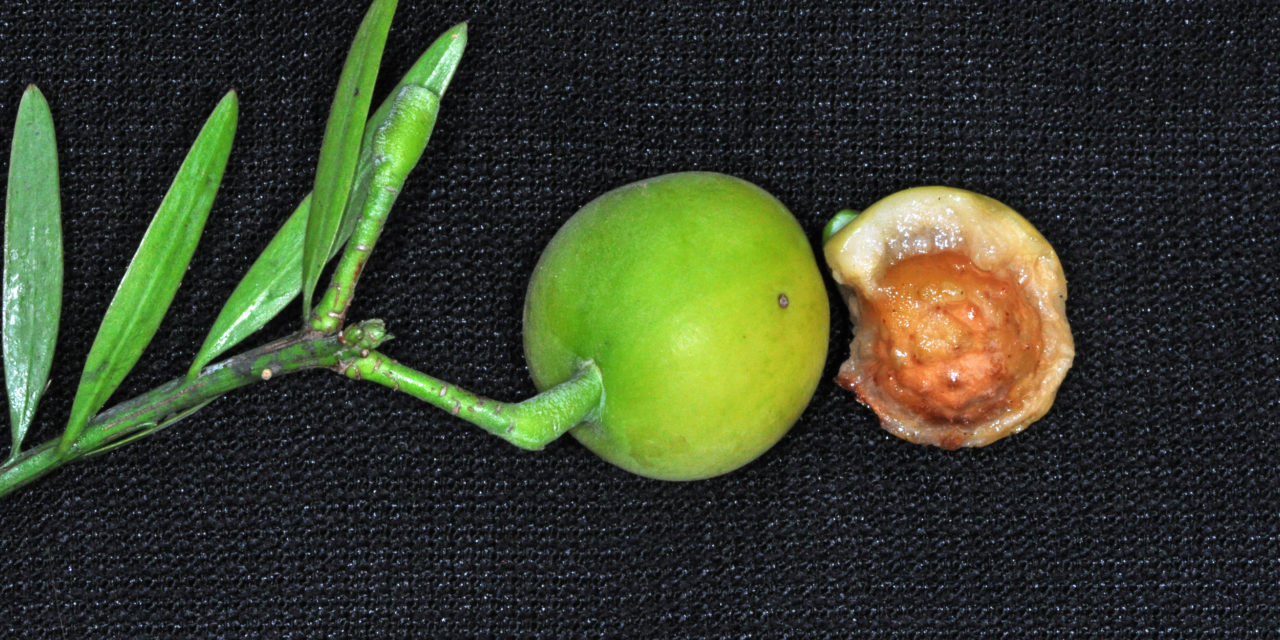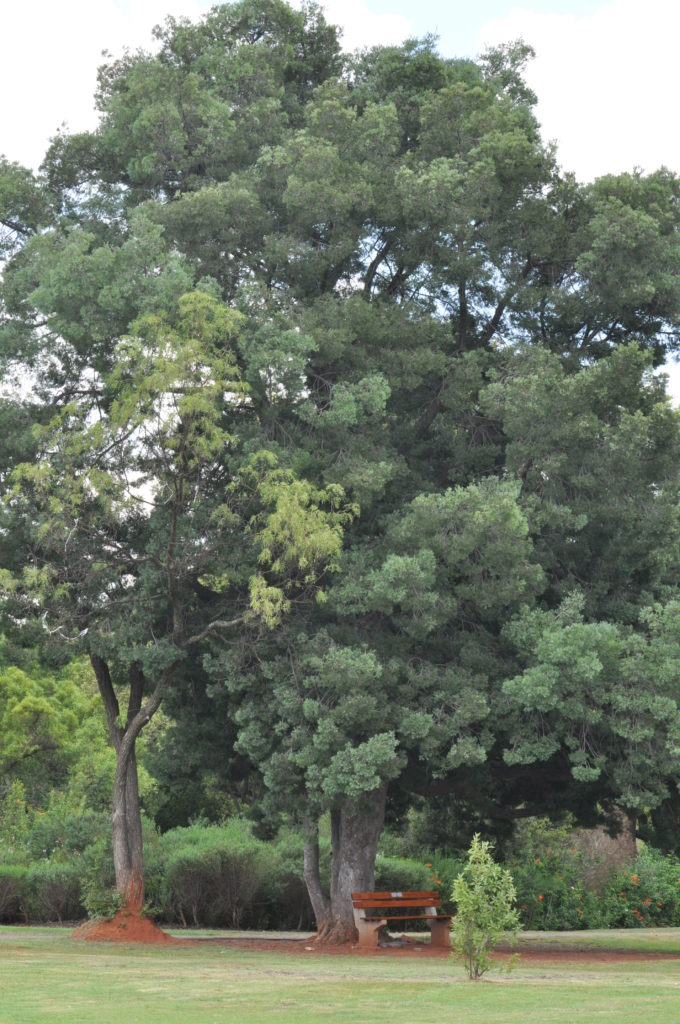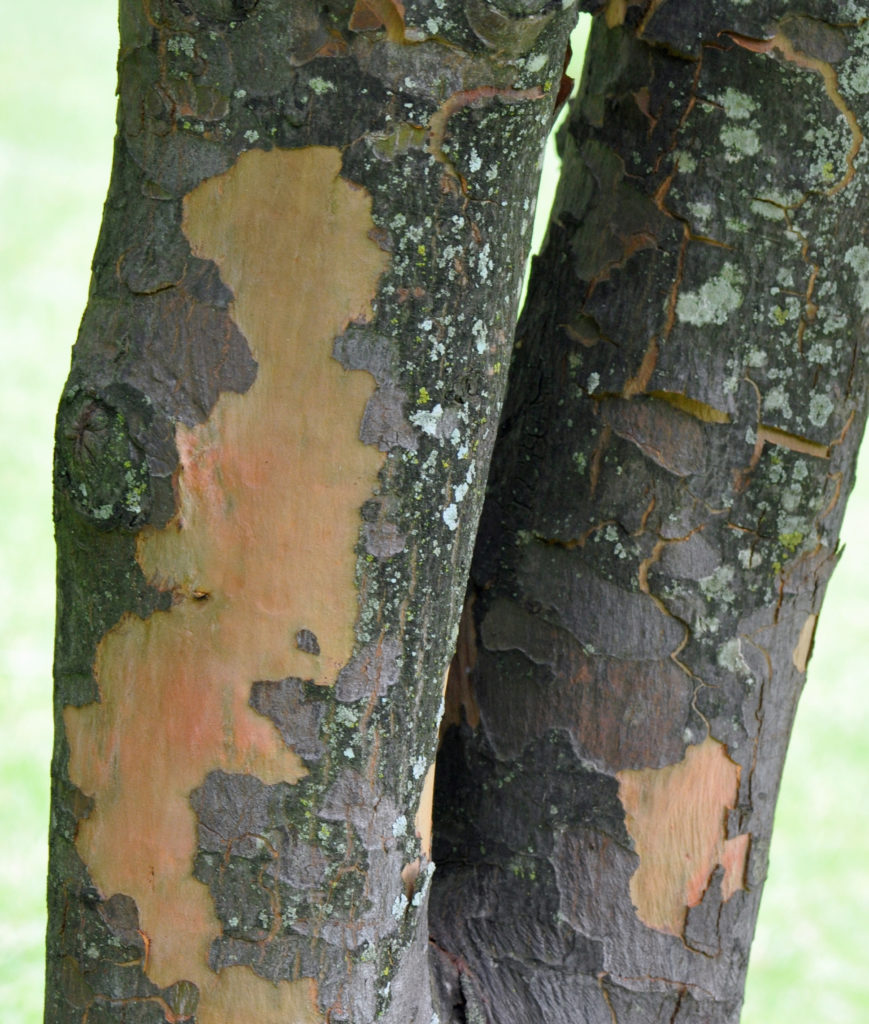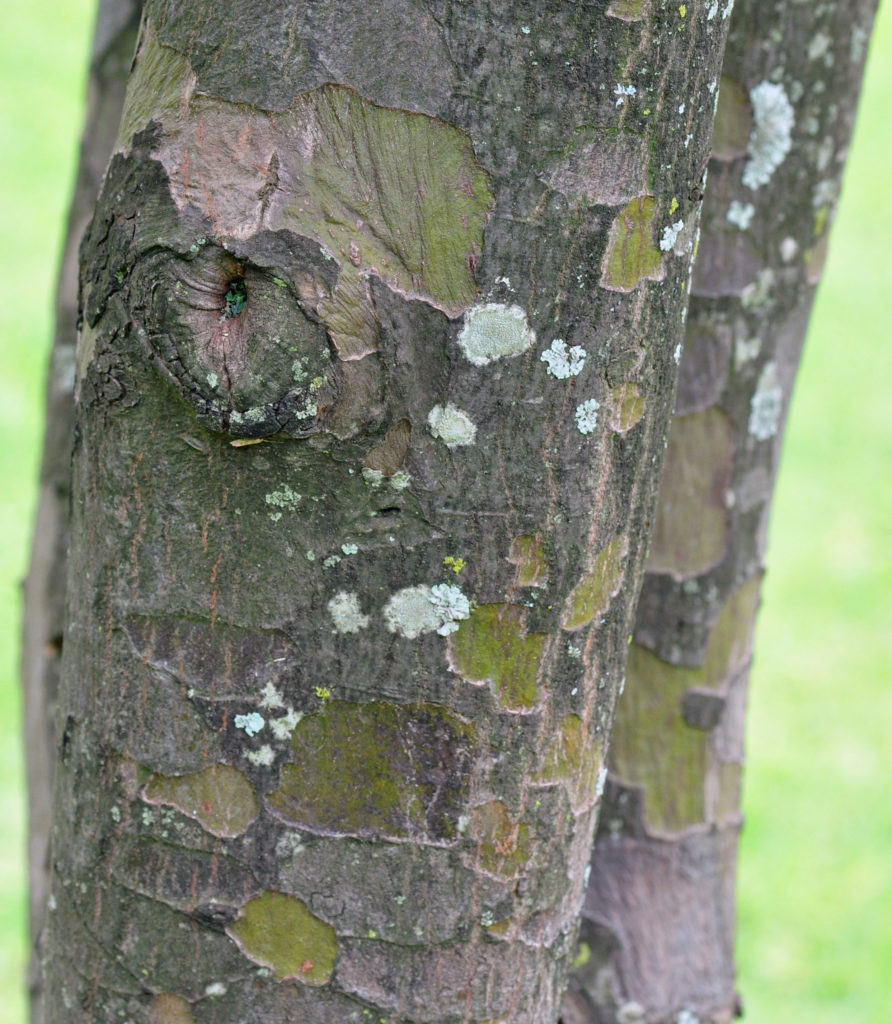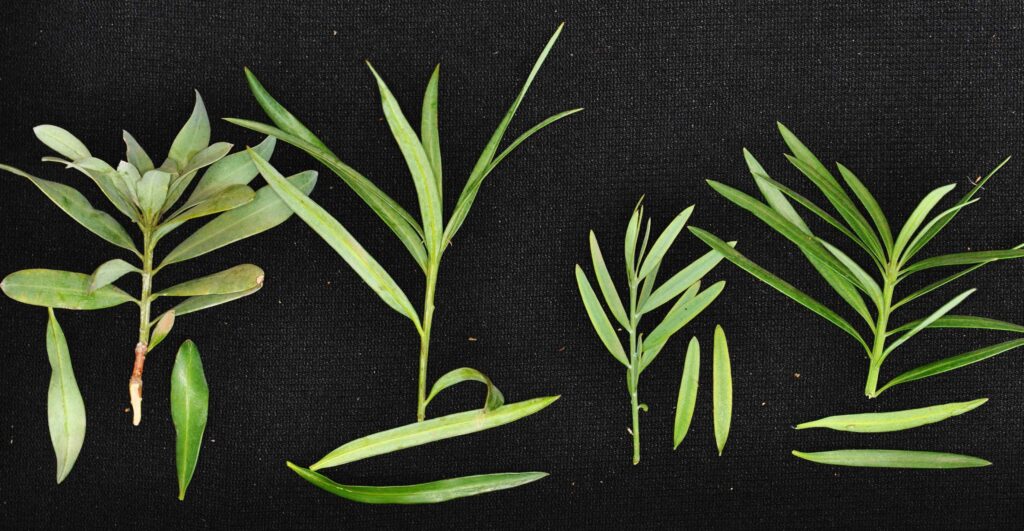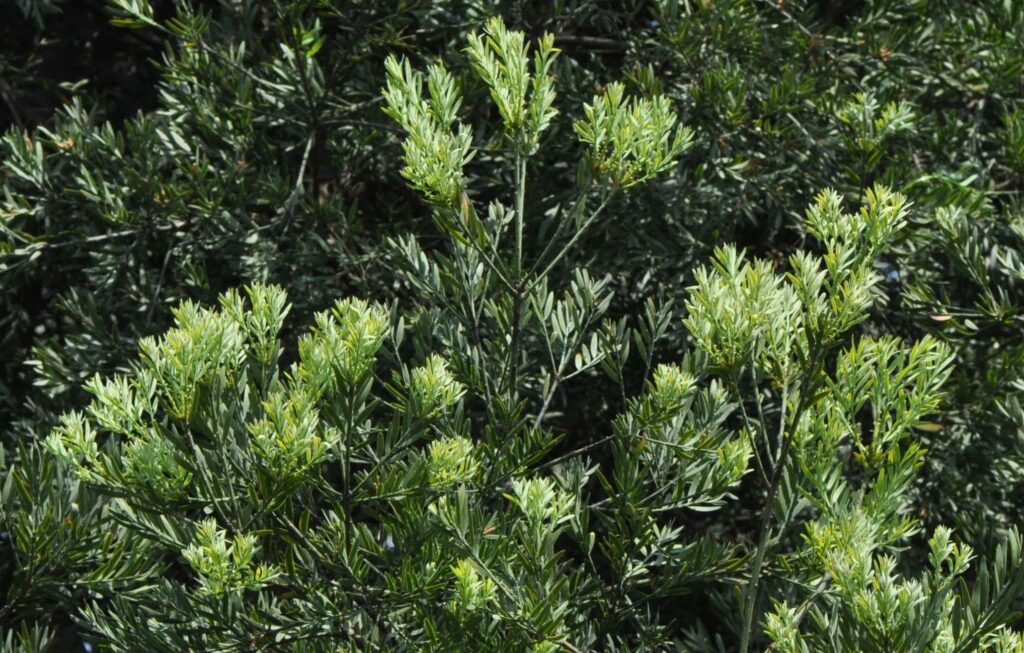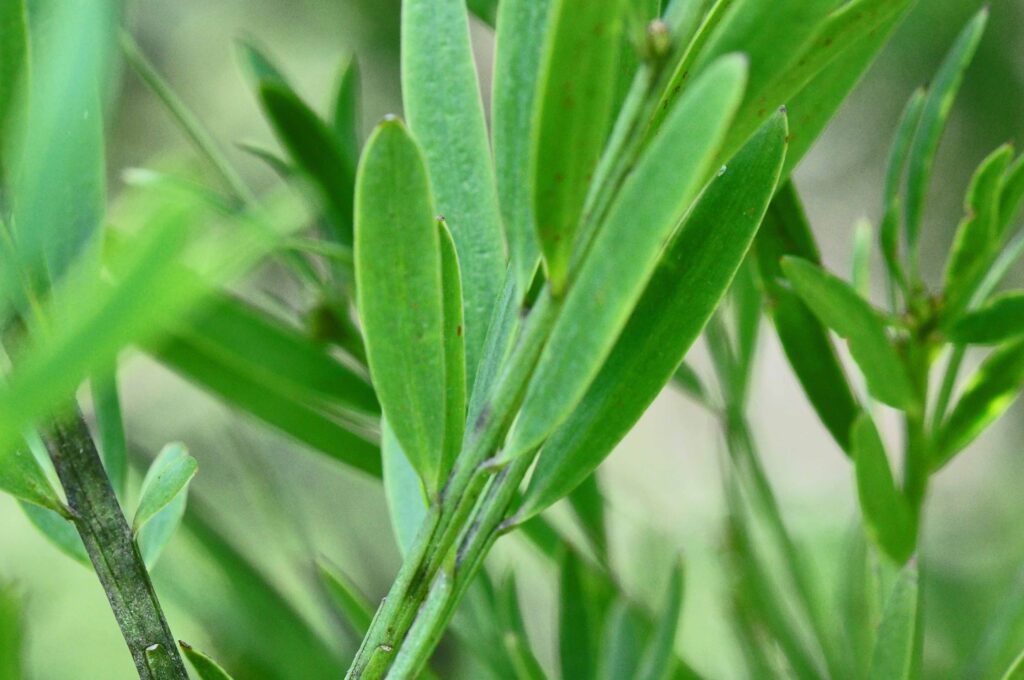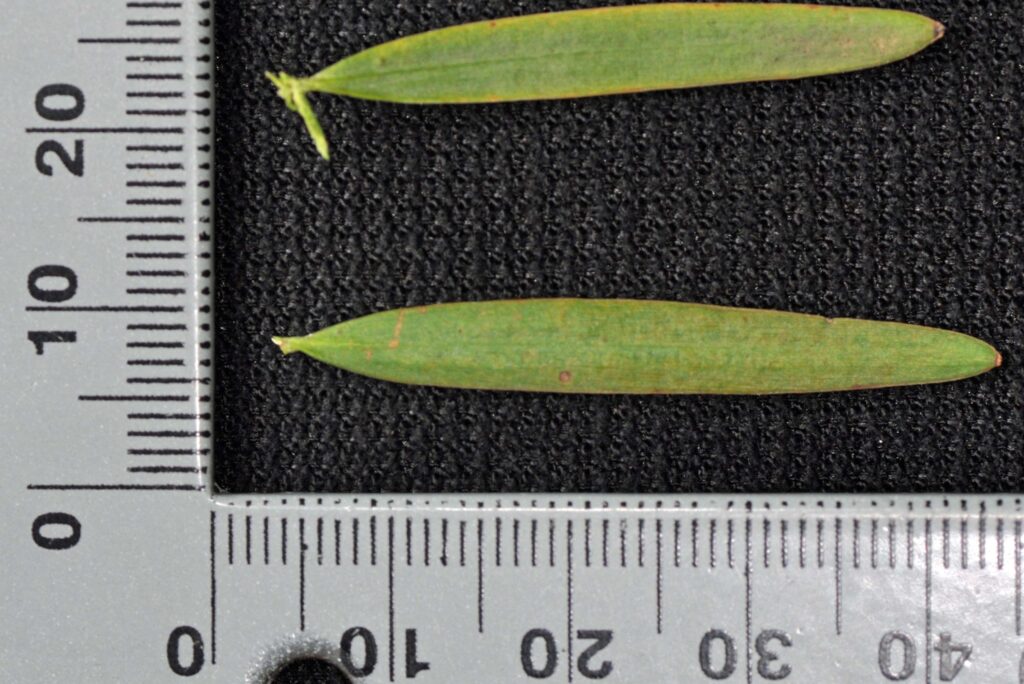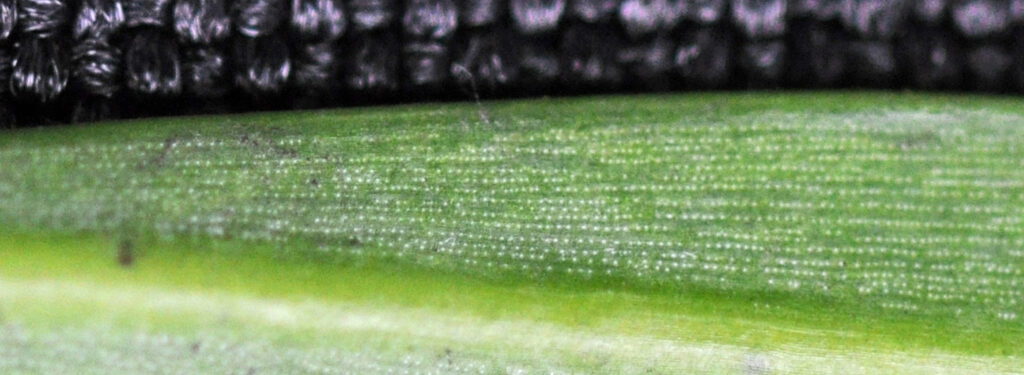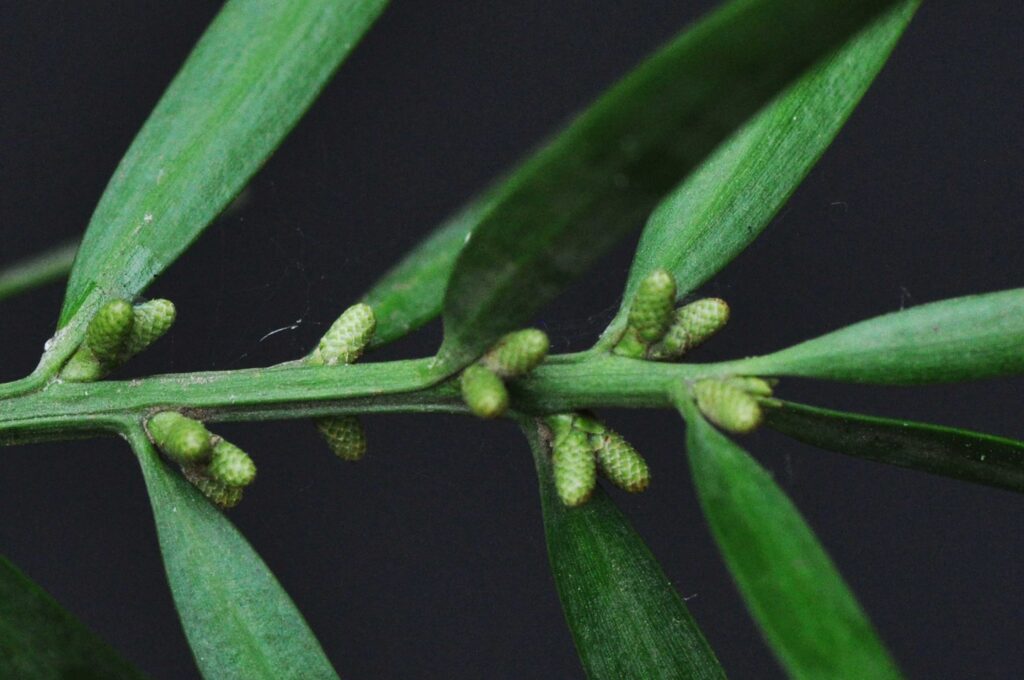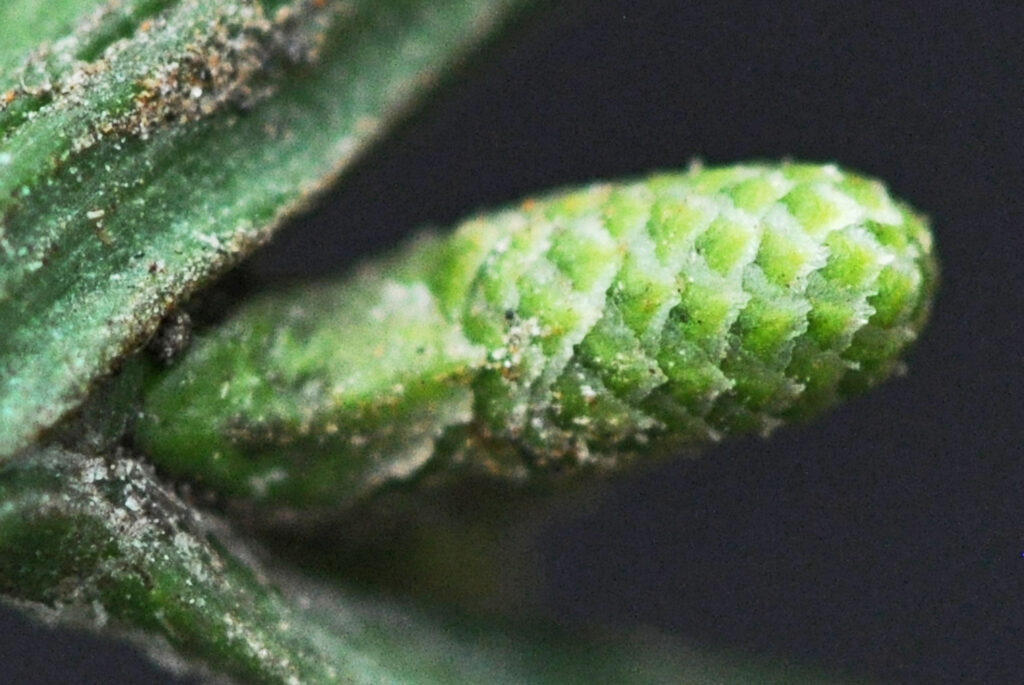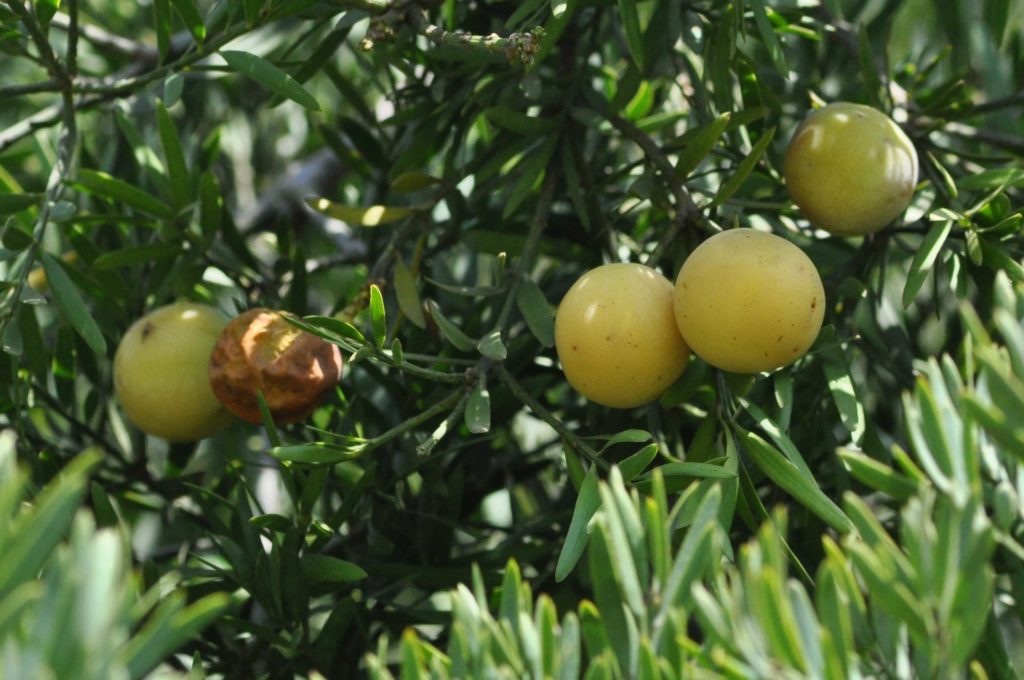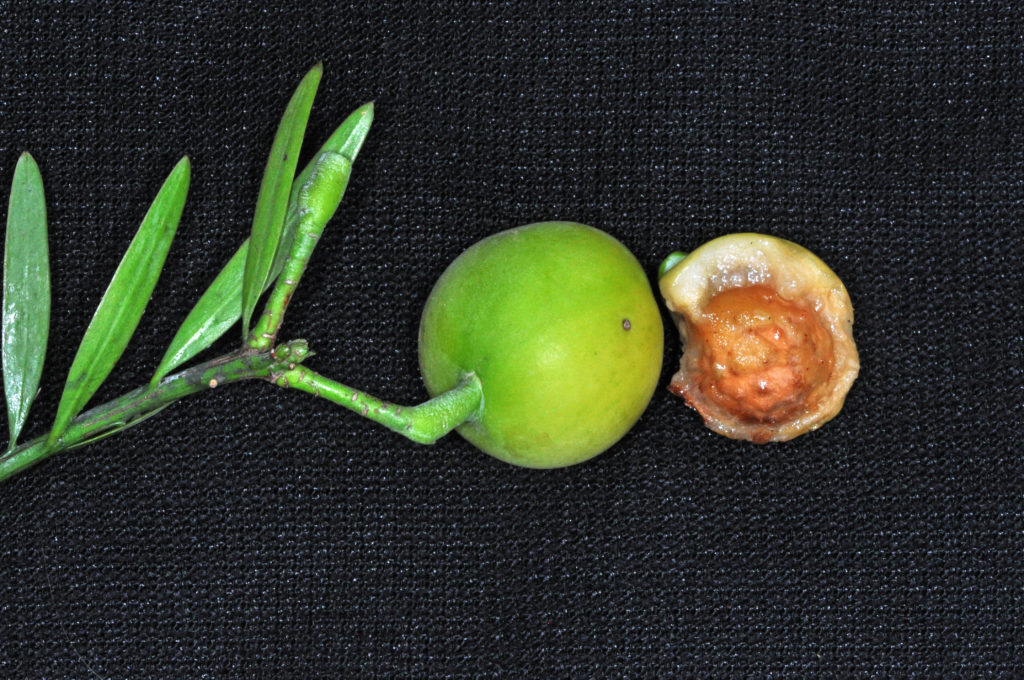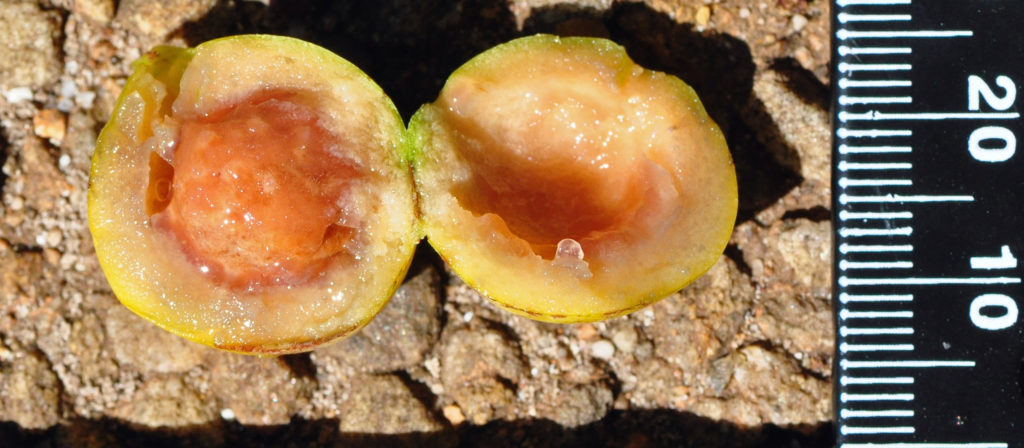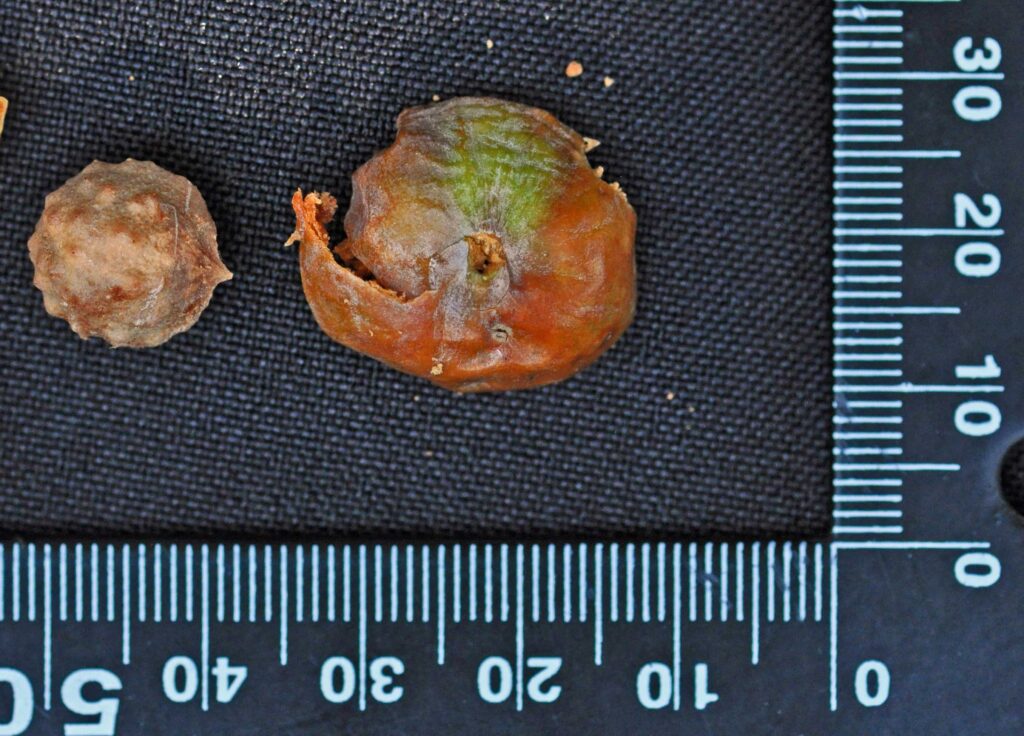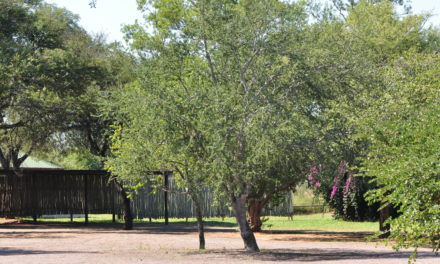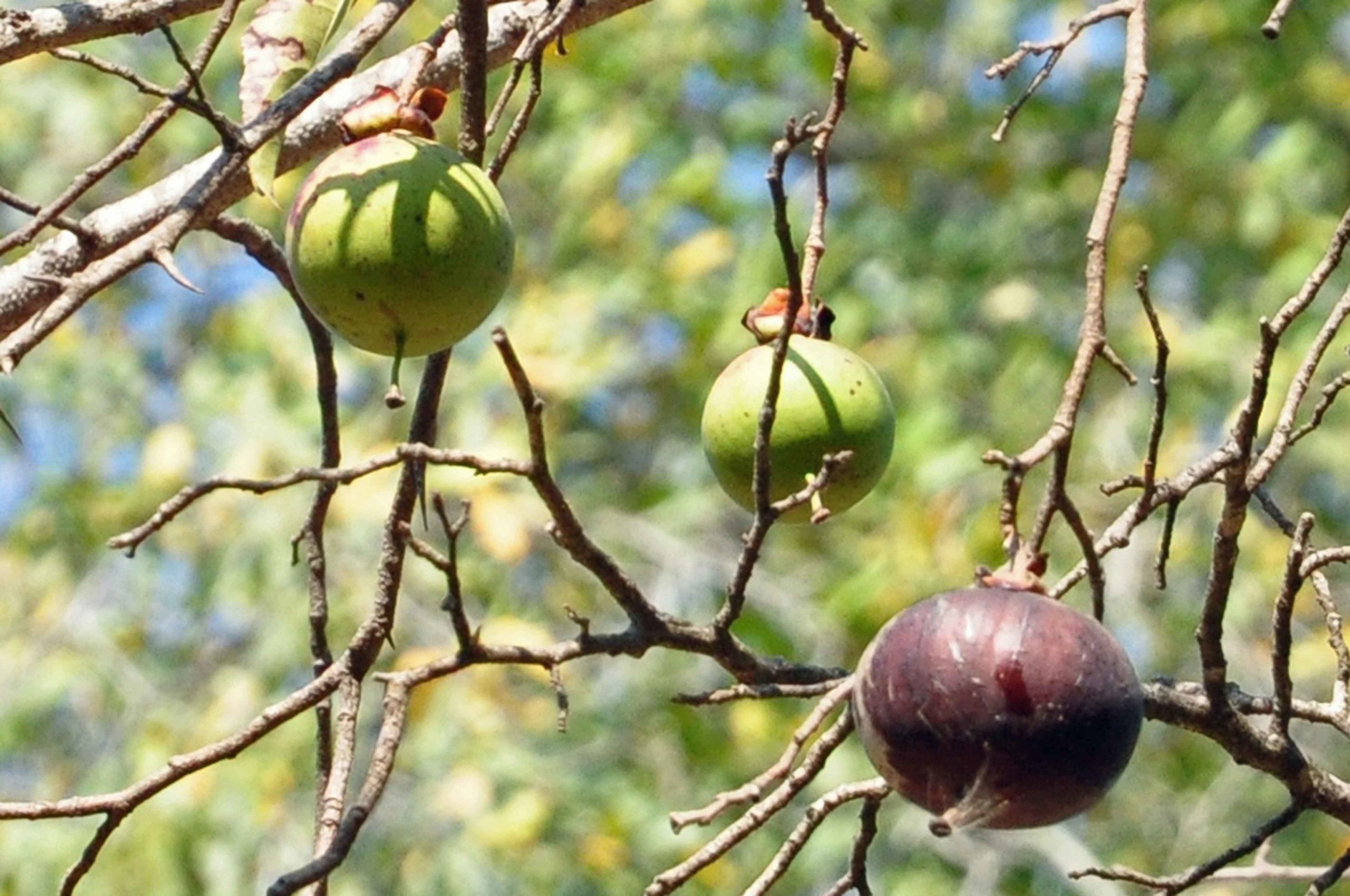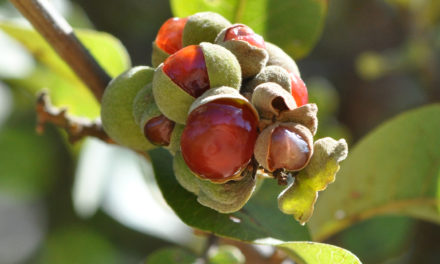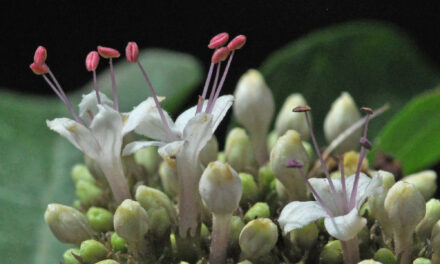General Info – summary
This dioecious Tree is up to 20+m high & a similar width. Uneven shed bark shows a lighter underbark. Simple, linear-lanceolate, evergreen & entire Leaves lack stipules. Reproductive structures lack a perianth. Male cones produce wind-dispersed pollen from many fertile scales in each cone. In females, the solitary ovules are not in cones and the receptacle is not swollen. Each Fruit has one hard, knobbly seed.
Description
Podocarpus falcatus
Previous Names: Afrocarpus falcatus, Decussocarpus falcatus, Nageia falcate, Nageia meyeriana, Podocarpus gracillimus, Podocarpus meyerianus, Taxus falcata.
SA Tree No. 16.
Common names: (Afr) Bastergeelhout, Blou-geelhout, Fynblaar-geelhout, Gewone Geelhout, Gewonegeelhout, Kalander, Kalandergeelhout, Kolander, Kroesgeelhout, Nietlandergeelhout, Nikolander, Outeniekwa-geelhout, Outenikwalandsgeelhout, Outeniquageelhout, Outeniquasgeelhout. (Eng) Bastard Yellowwood, Common Yellowwood, Falcate Yellowwood, Outeniqua Yellowwood, Sickle-leaved Yellowwood, Small-leaved Yellowwood, Smooth-barked Yellowwood. (isiXhosa) Umgeya, Umkhoba, Umkolaya, Umkoleya, Umngcondo, Ungeya. (isiZulu) Umgeya, Umhlenhlane, Umkhandangoma, Umomphumelo, Umphume, Umpume, Umsonti, Unomphumelo. (Northern Sotho) Mogôbagôba. (siSwati), Umsonti. (Tshivenda) Mufhanza. (Xitsonga) Akondangoma.
Family: Podocarpaceae. (A large family of mainly southern hemisphere conifers, which includes our Yellowwoods). The primary branches form pseudo-whorls around the trunk. The coriaceous Leaves are deciduous or evergreen (usually) and linear to narrowly ovate. A distinct Midrib is present. The evergreen trees or shrubs are usually dioecious. The Perianth is absent. The catkin like Male cones usually have many microsporophylls (fertile scales) each with 2 pollen sacs. Pollen grains usually have 2 air-bags or wings. Female cones have 1 or 2 fertile terminal scales and a few sterile scales. Ovules are solitary, inverted and enclosed in an epimatium (part of the scale supporting the ovule develops into a rounded covering enclosing the seed entirely). The Seeds, with 2 cotyledons (seed leaves), are borne on a receptacle, which is often swollen and fleshy. The seeds are not in cones. There are about 17 genera and 125 species in this family. Podocarpus is the only genus in southern Africa and has 4 species: P. latifolius; P. henkelii; P. falcatus and P. elongatus.
Name derivation: Podocarpus – podo (foot) karpus (fruit) referring to the fleshy receptacle on which the seed rest. However, the receptacle is not fleshy in this species. This resulted in the temporary name change to Afrocarpus – of Africa. falcatus – sickle shaped (referring to some of the leaves).
The genus Podocarpus was endemic in Gondwanaland – the ancient southern hemisphere supercontinent that comprised of a combination of South America, Africa, Antarctica, Australia and India. Some species of Podocarpus still grow in most of these places. All species of the genus Podocarpus (about 100) are woody evergreen plants.
Conservation: National Status: L C (Least Concern). Assessed: 2005. (W. Foden and L. Potter).
Tree
This is the tallest of our yellowwood and indigenous Trees (photo 357) and may reach close to 70m (usually less) e.g., the 600-year-old “big Tree” at Knysna. Here the crown has a spread of nearly 36 sq. m. This Trunk circumference is 7m and contains 48 cubic metres of wood. These trees all have a straight stem and are the quickest growing of our indigenous yellowwoods. They may survive for about a thousand years. In an open landscape, the tree has a dense pyramidal canopy. Young normally smooth Branches tend to droop, are often square in cross-section (photo 484 – under Leaves) and generally ridged by downward sloping petioles (leaf stalks). Current year branches are green (photo 484– under Leaves). Bark is a distinguishing characteristic. In young trees, the bark is smooth, thin, and rather greyish to purplish dark brown or chocolate coloured. In older trees, the bark is shed in roundish or uneven flakes. Directly after shedding parts of the bark, the much lighter, distinctive red-brown underbark is temporally exposed (photo 284). This is distinctive and occurs in midsummer. This soon darkens but the scars are still visible for some time (photo 238).
- 357. 2016/01/26. Pretoria NBG. Photo: David Becking.
- 284. 2015/12/15. Walter Sisulu NBG. Photo: David Becking.
- 238. 2014/02/04. Walter Sisulu NBG. Photo: David Becking.
Leaves
Photo 59 shows leaves of the different indigenous Podocarpaceae species. L-R: P. latifolius; P. henkelii; P. falcatus and P. elongatus. This is the order that they were planted at Walter Sisulu – moving away and slightly uphill from the waterfall.
On this evergreen tree, the small and narrow Leaves are simple (have a single blade which may have incisions that are not deep enough to divide the leaf into leaflets). Younger leaves are a light green (photo 324) and soft. The blue-green mature leaves are linear-lanceolate and may be falcate (sickle-shaped). They often have a greyish bloom. However, they can also be lighter and slightly yellowish. The usually spirally arranged leaves may initially be opposite. The raised parallel veined leaves (lower surface in photo 30) are hard, thinly leathery, narrow and up to 50 x 6mm. The Midrib is just visible on upper surface and slightly raised on lower surface. The Apex is initially pointed (photo 484). The Base tapers (photo 278) and, in order to hold the leaves upright, the leaf bases become twisted. The Petiole (leaf stalk) is short and may be twisted or absent. Stipules (basal appendages of the petiole) are absent.
- 59. 2016/01/05. Walter Sisulu. Photo: David Becking.
- 324. 2015/10/13. Walter Sisulu NBG. Photo: David Becking.
- 484. 2014/02/25. Walter Sisulu NBG. Photo: David Becking.
- 278. 2016/02/23. Walter Sisulu NBG. Photo: David Becking.
- 30. 2013/08/07. Walter Sisulu NBG. Photo: David Becking.
Reproduction
The Tree is dioecious (male and female parts are on different trees). The Perianth (calyx and corolla) is absent. It takes about 10 years for cones to start developing in axillary (between stem and leaf) buds. The up to 4 axillary elongated Male cones are initially green (photos 860 and 862) and become brownish and remain small – up to 15 x 4mm. They are composed of fertile scales, attached to the rachis (main axis) of the cone. Each scale has 2 tiny Pollen sacs on the lower side of the scales. They contain microscopic, winged pollen grains that develop on previous year’s twigs and take up to a year to completely mature. (Sep-May). The small Female Structures are about 10 x 2mm. They are axillary, on woody stalks and not produced every year. Unlike other indigenous yellowwoods, the receptacle is not swollen (photo 569 – under Fruit). A solitary Ovule is attached to the upper side of the separate fertile scale.
- 860. 2018/02/22. Ernest Ullmann Park. Photo: David Becking.
- 862. 2018/02/22. Ernest Ullmann Park. Photo: David Becking.
Fruit
The Fruit grows on a woody stalk and lacks the fleshy receptacle base (photo 569) present in other indigenous genera. This helps to distinguish it from Podocarpus latifolius, which has a slightly swollen fleshy receptacle. The Seeds do not occur in typical woody pinecone structure. In spring, the fruit becomes yellow and externally fleshy (photo 638 & 247) surrounding the internally woody shell with spike-like knobs (photos 569 & 608). Each hard ripe fruit is up to 2cm wide. This initially starts developing with the new leaves. Part of the scale supporting the ovule develops into a rounded fleshy covering, which encloses the seed entirely. This is an Arillode or false aril (a structure in certain seeds that resembles an aril but develops from the micropyle of the ovule as opposed to the leaf stalk). The single Seed contains 2 Cotyledons (primary leaves in the embryo). (Sep-May).
- 638. 2019/09/18. Walter Sisulu NBG. Photo: David Becking.
- 569. 2016/09/27. Walter Sisulu NBG. Photo: David Becking.
- 247. 2018.09/11. Kirstenbosch NBG Photo: David Becking.
- 608. 2017/10/24. Walter Sisulu NBG. Photo: David Becking.
Distribution & Ecology
Once it is established, this tree is one of the quickest growing of our indigenous forest trees. It can withstand some frost. These Trees are found from Swellendam in the Western Cape including the Big Tree at Knysna, through KwaZulu-Natal, Western Soutpansberg (far northern South Africa), Mpumalanga and Blouberg in Limpopo. They are mainly Afromontane (plant and animal species found in the mountains of Africa (up to 2 000m) and the southern Arabian Peninsula – common along the eastern highlands of Africa). These trees occur in Swaziland, Mozambique, Kenya, Tanzania, Malawi and northwards to Ethiopia. This tree is shade tolerant and is also found in coastal forests. Trees development is best in deep, slightly acidic and well-drained soils. The crown of these trees often has “Old Man’s Beard” hanging down from the high branches. This is a light green lichen (composite organism arising from a mutualistic relationship between fungi or cyanobacteria and algae species). Many Birds make their nests in this tree including Columba arquatrix (the African olive-pigeon or Rameron pigeon), and the endangered, endemic Poicephalus robustus (Cape Parrot). This is a short-tailed moderately large bird with a very large beak that enables it to break open the extremely hard seed (photo 608 – under Fruit). The Knysna Turaco (Knysna loerie) and some pigeons like the Delegorgue’s pigeon consume the fruit. Bats, monkeys, bushpigs and rodents also eat the Fruit but apparently do not help with dispersal. Fruit bats – including Egyptian fruit bat (Rousettus aegyptiacus) also feed on the fruit and play a part in the seed dispersal. There is a mutualistic relationship between the Roots and a mycorrhiza (an association between the root of a plant and a fungus that is mutualistic i.e., both benefit). This aids the tree in capturing nutrients e.g., nitrogen, sulphur and phosphorus. In return, the fungus gains carbohydrates such as glucose from the roots. This type of mutualistic relationship with plants and mycorrhiza has existed for a very long time.
Ethnobotany
This tree, together with Podocarpus latifolius, constitute 2 of the original great timber trees in South Africa. This straight growing tree has fine textured, pale yellow to pale yellowish-brown Wood that lacks resin and is easy to work with. It is known commercially as Podo. It is extensively used for shipbuilding (the density is about half that of water and thus floats well). The wood needs to be protected from fungal and insect attack. If seasoned it is suited for furniture, flooring, roof beams, boxes, for making plywood and musical instruments. Bark can be used for tanning leather. A chemical Podolide, has been extracted from leaves and has been shown to have in-vitro anti-leukemic properties. This is now a protected tree in South Africa. In order to cut this tree down here a license is required. Unlike the young tree, the adult tree grows relatively slowly. A young un-pruned tree casts a deep shade and inhibits grass from growing beneath it. The age of the stem can be roughly calculated by multiplying the stem diameter, in cm, by 4. Thus, a tree with a trunk diameter of 50cm would be about 200 years old. Large trees may extend above other trees in the canopy and their roots can cause problems with foundations. Trees developing below the canopy grow more slowly until they can obtain more light. In the forest, the trees are self-pruning but in the open, they do require pruning. Trees can be harvested for use after about 50 years. Plant seeds directly after collection. Male Podocarpus trees drop pollen, which is extremely allergenic. The red, purple or bluish fleshy Fruit of most species of Podocarpus is edible, raw, or cooked into jams or pies. They have a mucilaginous texture with a slightly sweet flavor. However, they are slightly toxic and should only be eaten in small amounts – especially when raw.
References
Boon, R. 2010. Pooley’s Trees of eastern South Africa. Flora and Fauna Publications Trust, Durban.
Burrows, J.E., Burrows, S.M., Lotter, M.C. & Schmidt, E. 2018. Trees and Shrubs Mozambique. Publishing Print Matters (Pty) Ltd. Noordhoek, Cape Town.
Coates Palgrave, M. 2002. Keith Coates Palgrave Trees of Southern Africa, edn 3. Struik, Cape Town.
Foden, W. & Potter, L. 2005. Podocarpus falcatus (Thunb.) R.Br. ex Mirb. National Assessment: Red List of South African Plants version 2020.1. Accessed on 2023/10/05.
Ginn, P.J. McIlleron, W.G. Milstein, S. 1989. The Complete Book of Southern African Birds. Struik Publishers (PTY) LTD. Third impression 1991.
Palmer, E. & Pitman, N. 1972. Trees of southern Africa. Balkema, Amsterdam, Cape Town.
Schmidt, S. Lotter, M. & McCleland, W. 2002. Trees and Shrubs of Mpumalanga and the Kruger National Park. Jacana, Johannesburg.
van Wyk, B. & van Wyk, P. 1997 Field guide to Trees of Southern Africa. Struik, Cape Town.
https://en.wikipedia.org/wiki/Afrocarpus_falcatus
http://edis.ifas.ufl.edu/st492
http://www.biodiversityexplorer.org/plants/coniferophyta/podocarpaceae/afrocarpus_falcatus.htm
http://www.saforestrymag.co.za/articles/detail/outeniqua_yellowwood_the_majestic_tree_of_our_natural_forests
http://www.plantzafrica.com/plantnop/podocarpfalcat.htm
http://www.prota4u.org/protav8.asp?g=pe&p=Afrocarpus+falcatus+Thunb.+C.N.Page
http://posa.sanbi.org/flora/browse.php?src=SP
https://www.conifers.org/po/Podocarpaceae.php

